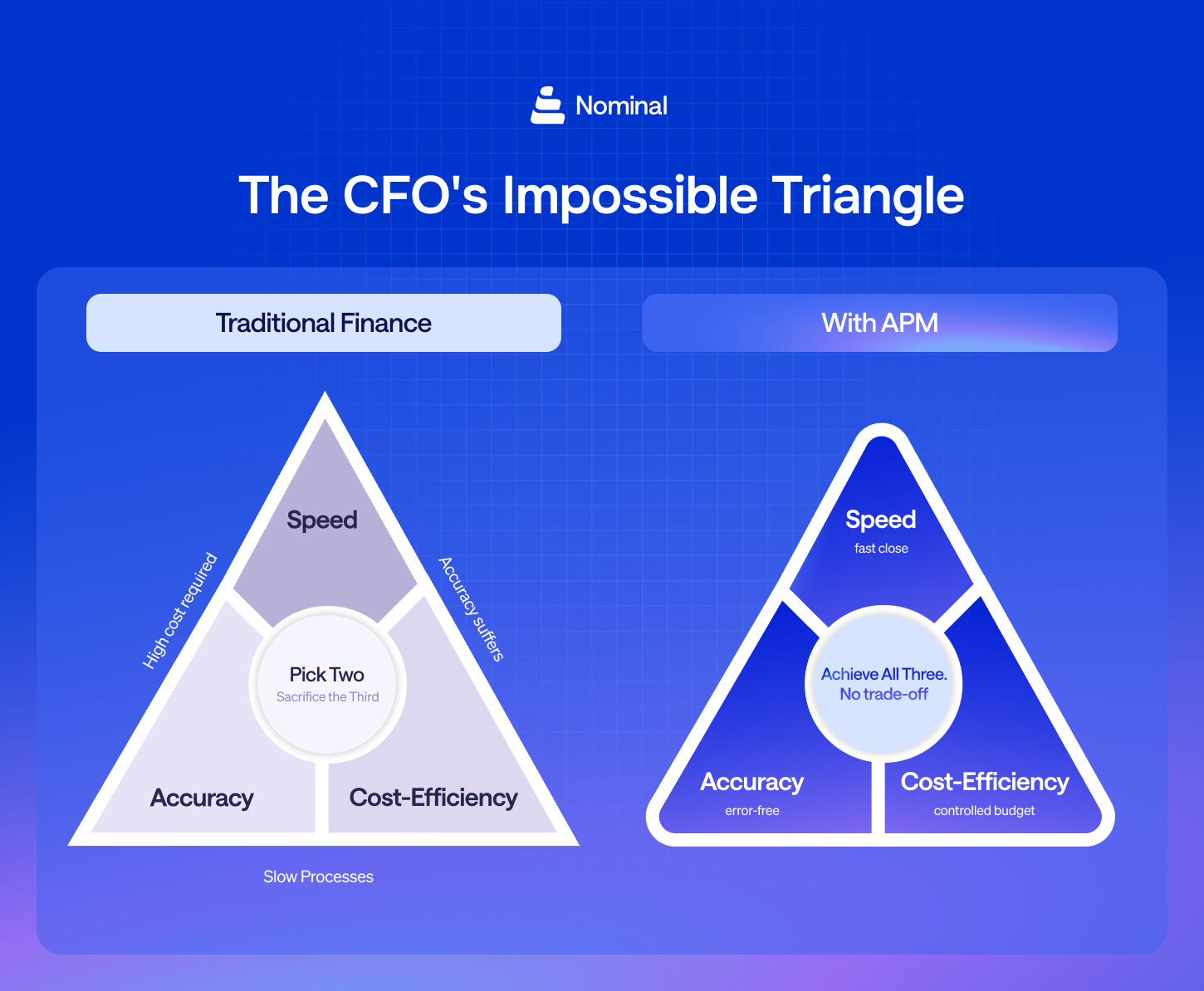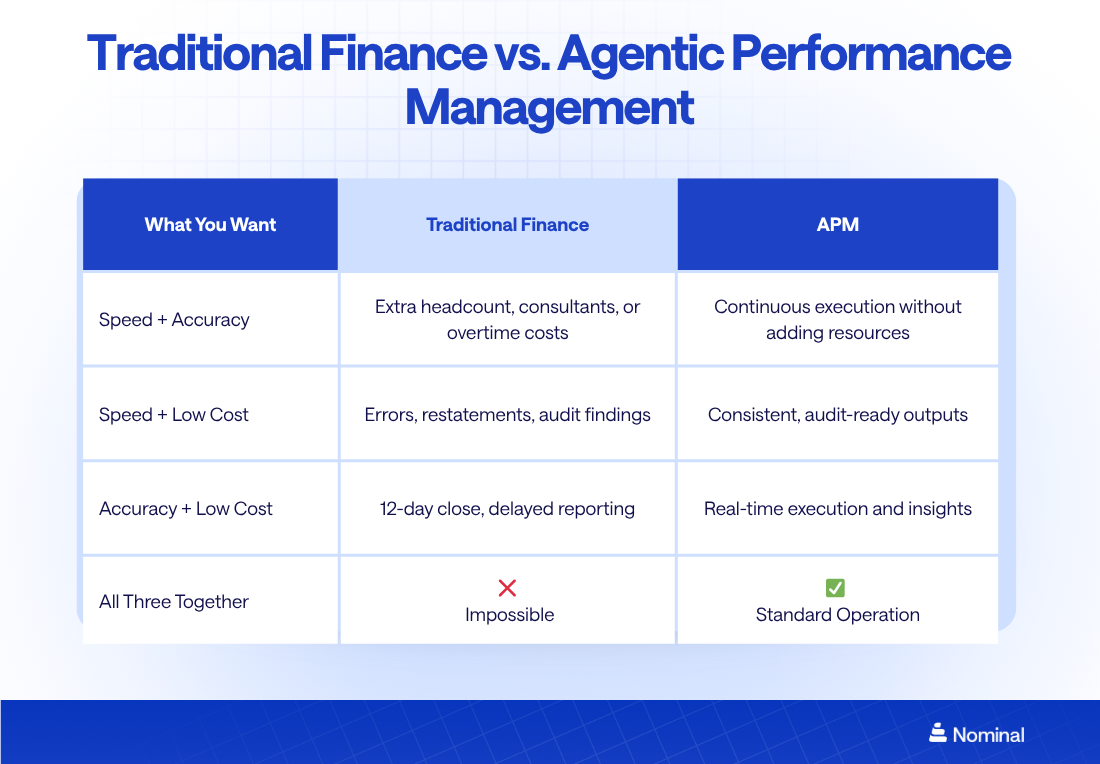
Finance leaders have always faced an impossible choice: fast closes with high costs, accurate reporting with slow turnaround, or affordable operations with errors. The CFO's Impossible Triangle forced trade-offs for decades. Agentic Performance Management breaks this constraint by delivering speed, accuracy, and cost efficiency simultaneously.
For decades, CFOs have operated under what feels like an unbreakable law of finance: you can have any two of speed, accuracy, or cost efficiency, but never all three. This constraint has shaped hiring decisions, close timelines, and operational strategies across organizations of every size. It became so ingrained that finance leaders stopped questioning whether it had to be this way.
The reality is that this trade-off was never inevitable. It was a symptom of manual execution capacity becoming the bottleneck in every accounting workflow. When humans perform reconciliations, prepare eliminations, and execute close processes, organizations face linear scaling constraints. More complexity requires more people. Faster timelines require overtime or consultants. Higher accuracy requires additional review layers. The triangle existed because the operational model demanded it.
That constraint no longer applies. Agentic Performance Management eliminates the manual execution layer entirely, allowing finance operations to deliver speed, accuracy, and cost efficiency at the same time. Understanding why the triangle existed and how it disappears reveals what becomes possible when finance stops being constrained by human capacity.
The CFO's Impossible Triangle Explained
The triangle presents three desirable outcomes that historically could not coexist. Finance leaders faced a forced choice between combinations that each carried significant downsides.

Speed and accuracy together demand high costs
Organizations that need fast closes without sacrificing precision hire additional staff, bring in consultants during peak periods, or pay overtime to meet deadlines. A company closing the books in five days with full multi-entity consolidation might employ three controllers, where one would suffice with more flexible timelines. The operational capacity exists, but the financial burden scales proportionally with complexity.
Speed and low cost together sacrifice accuracy
Teams rushing through reconciliations with minimal resources make errors. Intercompany eliminations get missed. Variances go unexplained. The close finishes on time and stays within budget, but restatements follow. Audit findings accumulate. Board confidence erodes when financial reports require constant correction. The organization moves fast and stays lean, yet the output quality suffers under pressure.
Accuracy and low cost together create slow processes
Finance teams that refuse to compromise on precision but lack resources to accelerate simply extend timelines. The close takes twelve days instead of five. Consolidation happens manually in spreadsheets with multiple review cycles. Reports reach leadership weeks after period end. The numbers are right, and headcount stays controlled, but the business operates on delayed information. Strategic decisions wait for accounting to catch up.
Every CFO recognizes this dynamic. Budget meetings involve choosing which constraint to accept. Growth planning includes calculating how many accountants each new entity requires. The triangle shapes what finance can deliver and what leaders must sacrifice to get there.
You might also like: How to Scale Finance Operations Without Adding Headcount: Data-Driven Insights from 50 Million Transactions
Why Finance Teams Accepted This Trade-Off
The Impossible Triangle persisted because the underlying architecture of finance operations left no alternative. Manual execution capacity became the fundamental constraint that limited everything else.
Accounting workflows require judgment at every step. Someone must review transactions, match payments to invoices, prepare journal entries, reconcile accounts, and validate consolidations. Technology could organize these tasks, route approvals faster, or suggest potential matches, but it could not perform the work itself. Humans remained in the execution path for every transaction.
This created linear scaling requirements. When transaction volumes doubled, reconciliation time doubled. When the organization added subsidiaries, consolidation work multiplied. When audit standards tightened, documentation requirements expanded. Each change demanded proportional increases in human capacity. Finance operations scaled the same way manufacturing scaled before automation arrived on factory floors.
Industry norms reinforced acceptance. A ten-day close cycle became standard because that represented how long manual processes required. Finance teams are sized according to transaction volumes because that determines workload. Controllers managed capacity constraints rather than questioning whether constraints could disappear. The triangle felt permanent because the execution model underneath it was unchanging.
What Happens When You're Forced to Choose
Operating within the Impossible Triangle creates tangible pain for finance organizations. The trade-offs manifest in burned-out teams, missed deadlines, strained budgets, and lost strategic opportunities.
CFOs
CFOs hire external consultants every quarter to meet close deadlines without expanding permanent headcount. The consultants arrive, execute reconciliations and eliminations, then disappear until the next cycle.
Costs spike during close periods, while accuracy depends on external resources learning company-specific processes under time pressure. The temporary capacity solves the immediate problem but creates dependency and unpredictability.
Finance Teams
Finance teams burn out under relentless execution pressure. Month-end becomes a week of late nights and weekend work. Controllers manage task lists instead of analyzing variances. Staff accountants reconcile transactions manually while strategic projects get postponed indefinitely.
Turnover accelerates as talented professionals leave for roles where they can apply expertise rather than execute repetitive processes. Organizations lose institutional knowledge and face constant recruiting cycles.
Finance Leaders
Some finance leaders extend close timelines to relieve pressure, only to lose board confidence when reporting lags competition. Executive teams make decisions with outdated information. Investors question whether finance operations can support growth. The organization avoids accuracy problems and controls costs, but leadership perceives finance as a bottleneck rather than a strategic partner.
Others push for speed regardless of consequences. Close cycles compress. Review steps get abbreviated. Errors slip through. Restatements damage credibility. Audit findings multiply. External auditors raise concerns about control environments. The cost appears manageable until the business impact of inaccurate financials becomes impossible to ignore.
The triangle forces choices that damage organizations regardless of which option leaders select. The real question is whether the constraint itself can be eliminated rather than managed.
How Agentic Performance Management Breaks the Triangle
Agentic Performance Management removes the trade-off entirely by changing the execution model that created it. Instead of tools that help humans work faster, APM deploys autonomous agents that own and execute complete accounting workflows. This architectural shift eliminates manual capacity as the limiting factor in finance operations.

Autonomous Execution Changes the Equation
Agents handle the operational work that previously consumed entire finance teams. They perform reconciliations by matching transactions across systems, identifying discrepancies, and resolving standard exceptions without human intervention.
They execute multi-entity consolidations by preparing intercompany eliminations, handling currency translation, and producing consolidated financials automatically. They manage month-end close processes by validating transactions continuously, posting recurring journal entries, and generating close documentation in real-time.
The distinction from traditional automation is fundamental. Robotic process automation follows rigid rules and breaks when data formats change. AI assistants suggest matches but require human review of every transaction. Workflow tools route approvals without reducing underlying work. Agents actually execute the accounting tasks from start to finish, escalating only genuine exceptions that require professional judgment.
This removes the manual bottleneck that created trade-off requirements. Speed no longer depends on how many accountants can work how many hours. Accuracy improves through consistent execution rather than depending on human attention during high-pressure periods. Cost scales with business complexity instead of transaction volumes because agents handle increased workload without additional resources.
From Trade-Offs to All Three Simultaneously
Organizations running on Agentic Performance Management achieve outcomes that were previously mutually exclusive within the traditional model.
Speed becomes continuous rather than cyclical. Agents execute reconciliations and validations throughout the month instead of waiting for period end. Close processes run in real-time as transactions occur. Finance teams review completed work rather than spending days gathering data and performing calculations. What previously required ten days of intensive manual effort now completes in hours because execution happens continuously rather than in compressed periods.
Accuracy improves through automation rather than additional review layers. Agents apply consistent logic to every transaction without fatigue or distraction. They maintain comprehensive audit trails automatically. They flag genuine exceptions while handling standard scenarios independently. Human judgment focuses on meaningful variances rather than routine validations. Error rates decline because consistent execution replaces variable human performance during high-pressure close cycles.
Cost efficiency scales non-linearly with complexity. When organizations add entities, agents extend their execution automatically without requiring additional headcount. When transaction volumes double during growth periods, operational capacity remains constant rather than becoming a bottleneck. When regulations change, agents adapt their workflows without a complete process redesign. Finance operations support business expansion without the proportional cost increases that manual models demanded.
The triangle disappears because the constraint that created it no longer exists. Finance leaders stop choosing between impossible options and start planning what becomes achievable when execution capacity is no longer the limiting factor.
Related post: Finance Doesn’t Need More Tools, It Needs Agentic Performance Management
What This Means for Finance Leaders
Breaking the CFO's Impossible Triangle creates strategic opportunities that were previously inaccessible. Finance transforms from a resource-constrained function managing trade-offs into operational infrastructure that enables business growth.
Capacity becomes a competitive advantage instead of a perpetual constraint. Organizations scale finance operations as quickly as they scale sales or product development. CFOs support acquisitions without multi-quarter hiring plans. Controllers add entities without expanding teams. Finance keeps pace with business growth rather than creating bottlenecks that limit what companies can pursue.
Strategic work replaces administrative execution. Finance professionals focus on variance analysis, process improvement, and decision support rather than reconciling transactions manually. Controllers design workflows that agents execute autonomously. Analysts interpret results instead of preparing reports. Teams apply expertise to judgment and strategy while agents handle operational execution that previously consumed entire close cycles.
Planning conversations with executive leadership has shifted fundamentally. When the CEO asks whether finance can support faster expansion, the answer changes from "we'll need to hire" to "our agents scale automatically." When the board requests more detailed segment reporting, the response becomes "we can implement that immediately" rather than "we'll need additional resources."
Finance stops negotiating for capacity and starts delivering capabilities that transform what organizations can achieve.
The Impossible Triangle constrained finance operations only because manual execution created unavoidable trade-offs. That constraint disappears when autonomous agents execute the work that previously required human capacity at every step.
The organizations that recognize this shift early will build finance functions that operate like reliable infrastructure supporting business growth. Those that continue managing trade-offs within the old model will spend years catching up after competitors have already transformed their operations.
Ready to break the triangle? Book a demo with Nominal to see how Agentic Performance Management delivers speed, accuracy, and cost efficiency simultaneously, eliminating the trade-offs that have constrained finance operations for decades.





